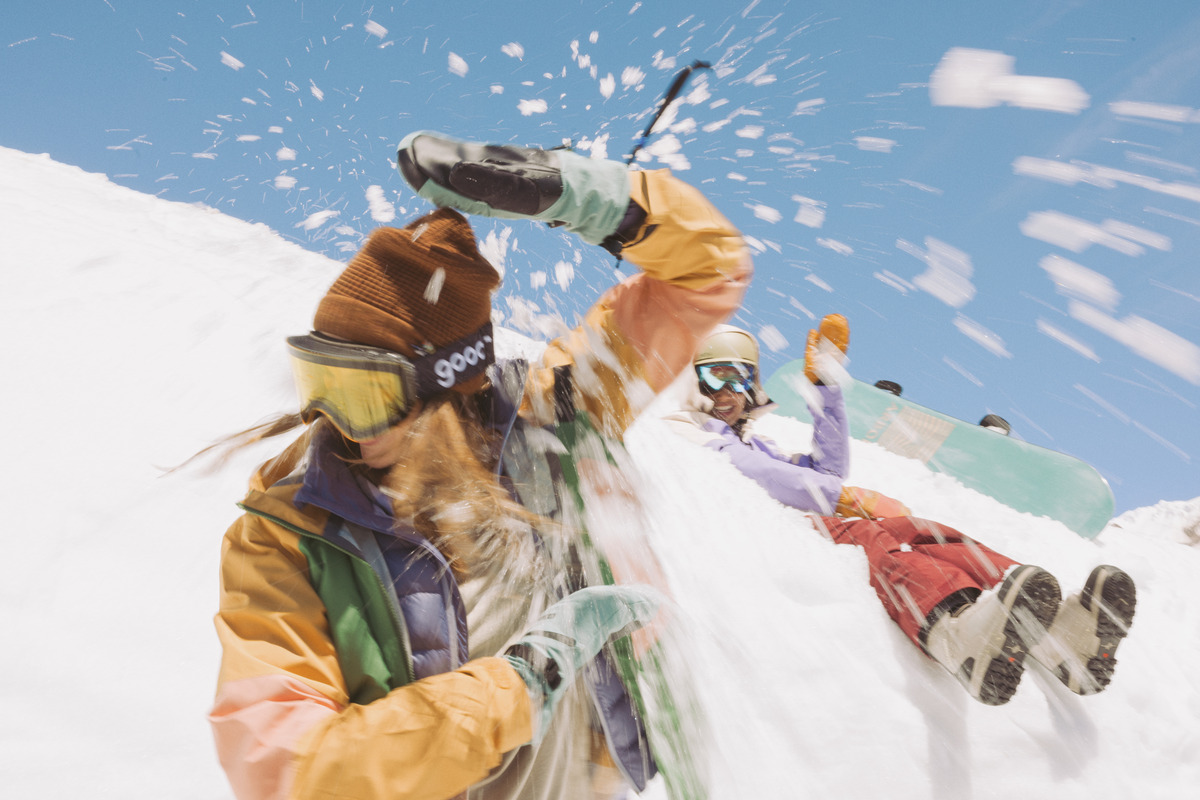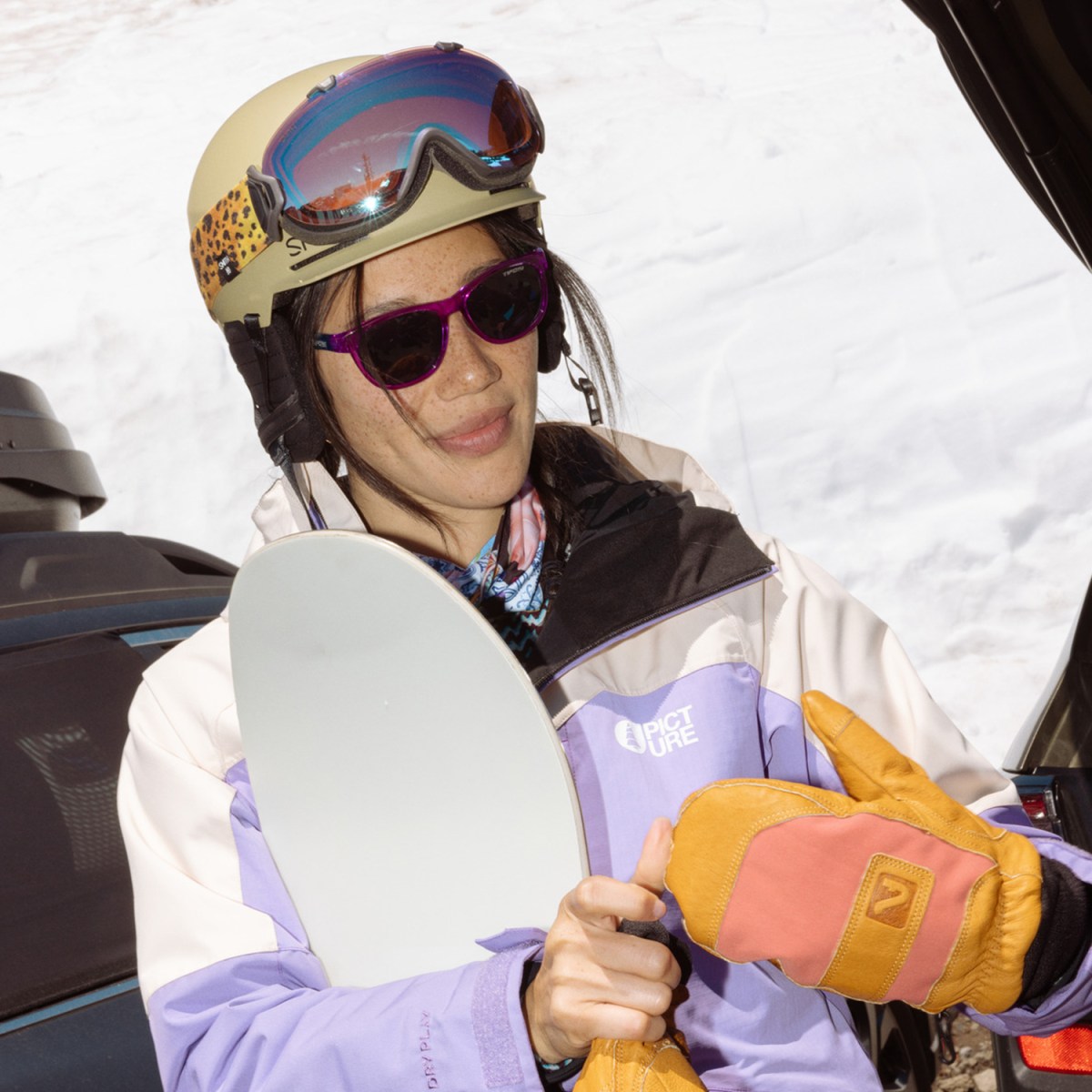Last December, just before a storm obliged Utah’s Wasatch Mountains with a desperately needed daub of primer, I grimaced at the barren range from a Brighton Ski Resort chairlift. A couple chairs were cranking and a few runs were open, courtesy of artificial snow. Across the canyon, popular backcountry zones were bone-dry, more suited to mountain bikes than skis.
I sat between two Picture Organic Clothing ambassadors, Jackie Paaso and Will Wesson. From a skiing perspective, the two couldn’t be more polar opposite. Paaso is a former Freeride World Tour competitor and Xtreme Verbier champion who lives in Åre, Sweden. She spends her winters developing SAFE AS women’s avalanche safety clinics and exploring remote ranges on human-powered expeditions. Wesson is a Utah-based street specialist and filmmaker who won X Games Real Ski gold in 2016. He has been at the helm of skiing’s longest-running webisode series (LINE’s Traveling Circus) for the past 15 seasons. Despite their divergent disciplines, both have built their lives on the same foundation: a passion for sliding on snow.
“In order for us to do what we all love, we need snow,” says Paaso. “Snow is king,” agrees Wesson, who’s careful to acknowledge that more is at stake than skiing in December. “In Utah, I can’t drink water and live here if there’s no snow. There are a lot of greater issues at hand.”

To Wesson’s point, according to a recent study on a “low-to-no snow future” in the western U.S., estimated water levels from snowpack are expected to decrease by about 25% by 2050. More alarming still: Within 35 to 60 years, low-to-no snow years may persist if greenhouse gas emissions remain at current levels. This shouldn’t just alarm skiers and snowboarders, but rather anyone who relies on the snowpack for agriculture and drinking water. Read: everyone.
Riding a chairlift up barren ski slopes should have skiers and riders concerned about more than core shots. So, what can individual skiers and riders do about climate change? In addition to voting for elected officials who support climate policy and contributing to nonprofits like Protect Our Winters, one answer is to think more deeply about the impact our gear has on the environment. And for Paaso and Wesson’s outerwear sponsor, sustainability isn’t a buzzword or a box to tick—it’s at the heart of Picture Organic.
Wishing for Snow Isn’t Enough
“The mission of the company is to fight climate change. So it’s really in our blood since day one,” says Picture cofounder and CEO Julien Durant. He launched the brand in 2008 with two best friends, Jérémy Rochette and Vincent André. “We’ve known each other since we were 12 years old,” recalls Durant.

The seeds for Picture were planted long before 2008 and watered every Wednesday, Saturday and Sunday, when the trio would meet at their local skate park or ski resort, depending on the season. That mutual love for the outdoors and board sports inspired the childhood friends to become business partners. The cofounders envisioned an apparel brand that blended the community fostered by Burton in snowboarding and the environmental commitment of Patagonia, says Durant. (In 2019, that vision came full circle, as Picture earned its B Corp Certification—joining the ranks of Burton and Patagonia—indicating that they value the intangibles often lost in the unabashed pursuit of profit, like social equity, environmental action and transparency.)
As Picture took root, the brand began manufacturing outerwear from recycled plastic bottles—a process commonplace for outdoor companies in 2023, but not so much in 2008, even though industry pioneer Patagonia had implemented the process as far back as 1993. For Picture, though, going the extra mile (and paying the extra euro) for recycled fabrics was worth it. Another material that’s been central to Picture’s casual apparel is organic cotton—hence the name “Picture Organic”—which reduces carbon emissions and uses less water than standard cotton cultivation.
“Everything we do is made up of recycled material, organic material, biosourced material. If it’s not possible to do a product that way, we don’t do the product,” Durant sums up.
To break away from petroleum-based fabrics and membranes—which are pervasive—Picture introduced several innovations to its outerwear line over recent years. Xpore, used in the Acidic 3L Xpore Jacket, is a PFC- and solvent-free waterproof and breathable membrane that’s mechanically stretched to create microscopic nanopores, keeping precipitation at bay while wicking perspiration.
In 2020, Picture integrated biosourced polyester, derived from inedible sugarcane waste, as a key material in technical products across the line. Always innovating, however, the brand moved away from bio-based polyester in 2023 in favor of a newer option: “circular polyester.” As the company explains, “this involves collecting and recycling used clothing (all brands) made of 100% polyester.” Add to it fabric scraps from the manufacturing process. And the result: Circular polyester made from about 60% fabric scraps and 40% used clothing. Both the Sitka Jacket and Bangup Jacket are made from 100 percent circular polyester.

Of course, there’s more to a brand’s search for sustainability than materials alone. “It has to be very durable, too,” says Durant, who wants Picture products to be hard-wearing, so people can “consume less and use more.” The brand launched a lifetime repair warranty program in 2020 that covers past season’s products too, so folks can get apparel repaired instead of replaced.
Shipping and packaging are other areas of focus. After REI Co-op requested that its vendors explore alternatives to poly bags made of petroleum-based plastic, which are ubiquitous in the apparel industry and landfills alike, Picture took a unique approach: contacting competitors.
By learning from brands like prAna, Picture shifted its packing strategy more quickly than it could’ve on its own. When possible, Picture removes plastic from the equation completely, nixing useless packaging. For streetwear, Picture uses “roll packing”—tying garments with recyclable materials and shipping them in a single, large poly bag and cardboard box. And for technical outerwear, Picture folds the garments into thirds, allowing them to fit into smaller poly bags. “Based on what we did five years ago, what we do today is 70% less plastic consumption,” says Durant. “So that’s massive, but it’s not finished.”
Worth Fighting For
It’s easy to ride a chairlift, shake your head at the lack of snow on the surrounding summits and move on with your life. It’s a little tougher to do something about it. Picture hopes to educate consumers so that no matter what brand they’re buying, they make informed decisions about sustainability features. As Paaso points out, “It’s really important to try to make the smartest choices we can when choosing what kind of equipment we throw on and use, how we get to the mountain and just making the best choices we can as individuals to help fight climate change.”
In that interest, Picture built an entire customer-facing website dedicated to sharing its fight against climate change. Don’t take our word for it: Click through and explore exactly what materials the brand uses, where they manufacture products and more.

Back on the Brighton chairlift, our early season stoke may have been momentarily tempered by the parched peaks around us, but at the top of the lift, we joined a heavy squad of Picture skiers and riders. We dropped as a mob, linking turns, hooting like kids on a playground, following one another off side hits and cat tracks, squeezing the lemon for all it was worth.
I confess, I wasn’t thinking about the snow water equivalent (SWE) of the American West, or the sinister specter of climate change, or the fact that Wesson and Paaso’s jackets were fashioned from sugarcane waste. I wasn’t thinking about the peaks beyond—or anything at all, really. I was just trying to keep up, enjoying a euphoric moment in the mountains—a moment made possible by winter and made better by the people you share it with. If you ask me, those moments alone are worth fighting for.
Editor’s Note: This article has been updated since it first published.
